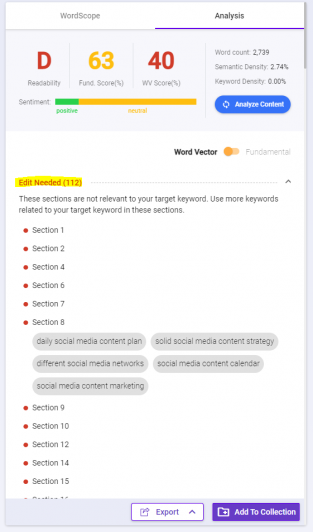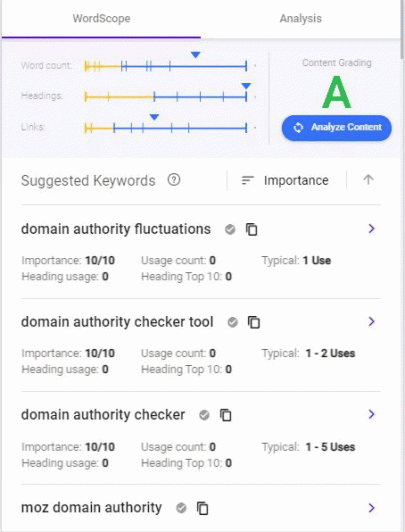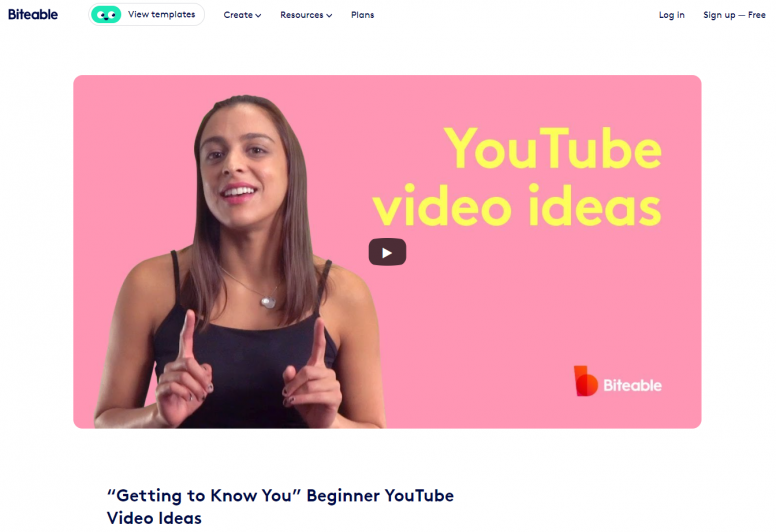The biggest challenges marketers face is to produce an SEO optimized content. BiQ's content intelligence shows how you can solve your content optimization problems all-in.
Read through to see how BiQ’s Content Intelligence can help solve your content optimization problems.
Most of us understand the necessity and importance of having compelling content. However, many forget the impact SEO optimized content can have on content marketing success.
At its heart, content intelligence enables businesses to:
- Understand how your audience interacts with your content and the content of your competitors
- Learn how to create better pieces of content that will increase audience engagement with your brand
Before you proceed, you ought to know that reoptimizing your content has one major benefit. Revisiting the old content creates an opportunity to refresh it by removing outdated data and adding something new.

Without the right Google-approved guidance, you’ll see yourself working for months or years doing the same thing to no avail. To many of you, optimizing content is done over and over again with no guarantee that your rankings or traffic will soar because all that was done was dependent on guesswork.
Not resolving important issues could cause you a lot. It may look small at first; spammy keywords in your content, irrelevant paragraphs to the title, or over-optimizing.
As a matter of fact, it’s easy to ignore when you first started off. But have you ever thought about what would happen a few years down the road when you have 100’s of content on your website?
You’ll have a lot to optimize!
Now, that’s not the case if you use BiQ. The content intelligence module will help you solve content optimization problems and take away all the possibilities of not knowing where or what to optimize. Let’s look at what problems content intelligence is born to solve.
Problem 1: You need to optimize for many contents quickly
How many excellent pieces of content do you have on your website now? When it comes to businesses and marketing, the quick turnaround of analyzing incoming content into actionable data assets is crucial.
This problem exists if you are asked to perform content optimization across your website. Things may take a long time if you have hundreds of content published on your website. So what would be the best way to optimize for many contents effectively?
BiQ’s Content Intelligence is here for your rescue.
Solution: You can easily insert hundreds of your site’s URL and their main keywords to have all the places that need optimization presented to you. Just start with entering your target keyword and URL if you have the article published.
Else, just key in the target keyword and hit enter. You will see yourself drafting from scratch (like on Google Doc, but smarter) with the intelligent content editor!

You will be returned with a comprehensive that’ll look like this.

Imagine all the time saved by just putting in your URL and having all the alerts that should be optimized right away shown to you!
Problem 2: You don’t really have a clue if your readers and Google likes your content
No matter how big your content marketing team, how much (or how little) content you already have, you’ll need a way to analyze your SEO content. All of the assumptions you’ve made previously aren’t necessarily true.
You had no information about the intent of the leads a piece of content may generate. You also have no guarantee if they will actually consume the information. And you have even less of an idea about the interest your content is generating without optimizing your content correctly.
That is to say, without content optimization tools like BiQ, you’re merely depending on guesswork and flying blind when it comes to working on SEO-optimized content.
Solution: BiQ’s Content Intelligence incorporates AI guidance that ensures consistency in brand, message, and style across all content. This also helps you make better, data-driven decisions that help create more effective content.
Knowing bits and pieces of this information will allow you to gain insights into which paragraph you can further optimize, modify, and rewrite. See how the content analyzer identifies issues in your content and get recommendations on fixing them.
All these are done by separating big chunks of content into paragraphs with their unique analysis. Here’s a breakdown of what the analyzer will show you; relevancy value, type of sentiment, and readability of each and every paragraph.

At the top of the analysis, you will be able to see the keyword, title and meta description of the content. The title is the first thing that your readers will see so make sure it gives a concise and accurate value of what your content will bring. As for the meta description, it gives you the opportunity to elaborate in short sentences to tell what your content is about.
Moving a little lower and you’ll see paragraphs separated by lines and each of them has its own analysis and results. BiQ’s line-by-line analysis helps you achieve maximum precision to know if each paragraph is contributing to the SEO of the page.

In the first row, BiQ first tells you the relevancy of each paragraph. Depending on whether the relevancy shows “Edit Needed”, “Good” or “Great”, you’ll have to modify the paragraph to better match your reader’s search intent.
The next row shows the analysis of the paragraph’s sentiment. Understanding your reader’s emotions is essential because it allows you to see what specifically made them react positively or negatively.

Powered by BiQ’s deep neural network, it quickly grades your writing into 9 different categories: Analytical, Joy, Fear, Tentative, Angry, Sadness, Confident, No Tone.
The third and fourth section talks about readability. It tells you how easy it is to read the paragraph. Little do people know it is a major factor in online content and it can greatly increase your site’s SEO levels. It is a practice of making your writing understandable and easy to digest for your readers.
And of course, less is more. Don’t overwhelm your readers and stick to shorter paragraphs with some visuals in between. Your readers will thank you for that.
Problem 3: You are afraid that you might over-optimize
Are you aware that over-optimizing your content can hurt your rankings? Too much of anything is never healthy, and that certainly holds true with optimization techniques.
In fact, Google has been penalizing websites that over-optimize. Acts like keyword stuffing, linking to toxic websites, keyword-dense URLs, and so on. If such cases were to occur, your readers will be having a bad experience as your content will be hard to read. Be prepared to bid goodbye to your traffic and rankings either.
Solution: Over-optimization won’t happen if you use BiQ. This is because you’ll receive AI-Guided content optimization steps in 2 major sections: Word Vector & Fundamental

Let’s look at these sections part by part.
(i) Word Vector
WordVector is an AI model pre-trained by Google. It is an algorithm that helps Google learn about the relationships between words, based on examples of actual language usage.
BiQ realizes the importance of WordVector in today’s SEO world. Thus, BiQ created WordVector to help you to analyze and improve your content relevance against the top 10 rankings.
WordVector will analyze your whole content and show you which section of your content needs editing to increase its relevancy.
The best part about this feature is that it can tell you exactly which paragraph has lesser relevance to the overall content.
With ease, you will be led to the “Edit Needed’ section to check which exact paragraph needs revision. You can also see the dropdown for “Good” and “Optimized”.

- Edit Needed – Represents critical errors that you must look into to fix them. We recommend that you do not publish content that contains a lot of errors as you may lose in traffic
- Good – These sections are considered relevant to your target keyword. Use more keywords related to your target keyword in these sections to further improve the relevancy.
- Optimized – Means a job well done!
(ii) Fundamental
‘Fundamental SEO’ will look into on-page optimization.
Just like ‘WordVector’, you will be presented with important insights on how many items need your immediate attention or items that need extra precautions to improve your ranking.

Problem 4: You need to analyze lesser-known factors that can bring change to ranks
It almost goes without saying, but let’s emphasize it anyway: if you don’t incorporate the right keywords in the right pages, these pages will not rank well for these keywords. But how do you do that effectively to increase the findability of these pages?
It’s by making certain elements of your priority.
As we all already know, there are close to 200+ ranking factors, and the more we hear, the more complicated it becomes. So rather than taking all of them, BiQ’s Content Intelligence will show you 20 that we think most deserve your attention.
Solution: With BiQ, you’ll get to enjoy an enterprise-grade assessment of your site’s strengths and weaknesses that will be presented to you in detail. These are 20 important content SEO best practices that BiQ takes into account in no apparent order:
1. Keyword in the title tag

Title tags can do wonders for your SEO when optimized with the right keywords. Put in your most relevant and desired keywords you want to rank for in the title, but don’t overdo it.
3. Keyword in the meta description

A page’s meta description should employ the keywords that the page is targeting, but also create a compelling description that a searcher will want to click.
4. Meta description length
Google generally truncates snippets above 165 characters. You should take enough space to get the message across, but keep it short and snappy at the same time. BiQ will keep your description length in check.
5. Keyword appears in the URL
Keywords in URLs are a very small ranking factor and user friendly. Having keywords in the URL does affect rankings for individual keyword phrases, but it can impact long-tail searches according to research.
6. URL Length

Maintain your URL length in under 60 characters that the Content Intelligence will guide you with.
7. Keyword appears in the H1 tag

Header tags are an important on-page SEO factor because they’re used to communicate to the search engines what your website is about. The H1 tag should contain your targeted keywords, those that are closely related to the page title and content.
8. Keyword appears in the H2, H3 Tags
The H2 tag is a subheading and should contain similar keywords to your H1 tag. Your H3 is a subheading for your H2 and so on. Think of them as a hierarchy based on importance, the above being more important than the below.
9. Keyword appears in the first paragraph
Many experts believe that Google gives more weight to the first 200 words in your content. The reason why is because usually, the first 100-200 words of an article are where a content writer sets up the introduction of what will be discussed.
10. Keyword appears in the last paragraph

Similarly, the conclusion (or last 200 words) could be argued as just as important if not more important. For this reason, try to include your primary keyword again near the last paragraph.
11. Keyword appears in the anchored link
Using keywords in anchored links is also known as creating an internal link structure showing Google where the most important articles are for exact keyword phrases. You can use anchor text links of certain keyword phrases to drive the authority of other “pillar” pieces to your content.
12. Keyword decorations
They refer to the use of bold and italic text for SEO writing. It is an effortless way to quickly point out information on a page that is relevant to the user. This engagement is what helps with ranking as the more your users scroll, click, and navigate around your website.
13. Content length

Studies show that longer content dominates page one of search rankings. Just look at BiQ’s blogs, they all have words that exceed 2,000 on average. Don’t get it wrong that those with longer content will surely rank high. Google awards long-form content based on the value it provides to users.
14. Keyword density
There may not be a perfect % for you to aim for but you can avoid the risk of keyword stuffing with BiQ’s optimization guidance. Always strive to write naturally and include the keyword phrase once or twice to rank in Google and avoid content optimization problems.
15. Related keywords

To really write smart copy, you should look at terms related to what you are targeting and how Google associates those terms. Then incorporate those semantically related terms into your content to help your content rank better.
16. Multimedia

Having a strong multimedia content strategy helps to effectively and efficiently reach your entire audience. The content you create should be as diverse as it is rich. It’s about creating relatable content that your followers can respond to and engage with.
17. Images have Alt text
Alt text is like using some kind of visual cue to help educate, engage, and inform your readers. They provide better image context/descriptions to search engine crawlers, helping them to index an image properly.
18. Keyword appears in the alt text
In terms of keyword usage, using your keywords in an image alt-tag can help it be shown during image searches or if the image is down.
19. Semantic density
You can analyze your top keywords and work out why your competitors are ahead of you. Using the semantic density indicator, you can quickly find growth opportunities for your site and find and why you rank lower than you should.
20. Reading level
Readability is a major factor in online content and can greatly increase your site’s SEO levels. It is the practice of making your writing understandable and easy to digest for your target audience. When it is clear, search engines and readers will favor your site.
BiQ, Your Best Bet To An SEO Optimized Content
By following BiQ’s content intelligence guidelines, you’d go home with a perfectly optimized page at the end of the day.

Content intelligence relies on data computation to work. This means the insights it provides are only as good as the amount and quality of the data you have. The first step to ensuring you have good data is to conduct a search with BiQ’s Content Intelligence module.
To leverage this technology for competitive advantage requires as long a history as possible of well-structured, well-maintained, trustworthy data, all that you will find from BiQ.
If there are any other content optimization problems that you need help in solving, don’t hesitate to drop me a comment below! I’ll be more than happy to discuss it with you and help make BiQ a better companion for you.





